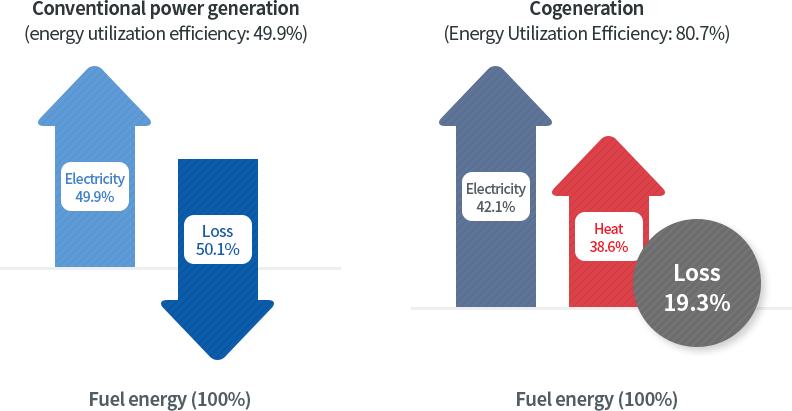- What is district heating?
- It is an advanced heating system that does not install individual heat production equipment in apartments, businesses, and commercial buildings but supplies to large areas heat (hot water) produced economically in a large-scale heat production facility such as a cogeneration plant.
Heat supply system diagram

- Heat production facility
- Cogeneration plant
- Peak load boiler
- Resource recovery facility
- Landfill gas (LFG) boiler
- Heat transport facilities
- Heat transport pipe
- Heat use facilities
- Apartment
- Business, commercial building, public institution, etc.
Effect of District Heating
It saves energy.
Unlike the conventional power generation facility that produces only electricity, cogeneration facility that produces electricity and heat at the same time has doubled the energy utilization efficiency.

- Comparison of energy used and lost when 100% fuel energy is used
- Conventional power generation (energy utilization efficiency: 49.9%)
- Electricity energy : 49.9%
- Loss energy : 50.1%
- Cogeneration (Energy Utilization Efficiency: 80.7%)
- Electricity energy: 42.1%
- Heat energy : 38.6%
- Loss energy : 19.3%
It improves the atmospheric environment.
Reducing fuel use and installing advanced anti-pollution facilities have reduced air pollutants such as sulfur oxides (59%) and carbon dioxide (51%), which causes global warming.
- Reduction of air pollutants (as of 2019)
-
- Individual heating 10,200 tons
- District heating 4,159 tons
Saving 59% (6,041 tons)
- Amount of greenhouse gas reduction (as of 2019)
-
- Individual heating 17,912,000 tons
- District heating 8,849,000 tons
Saving 51% (9,064,000 tons)
It's economical.
- Heat is produced economically in large-scale heat production facilities, and replacement, repair, and maintenance costs for the own heat production facilities are also reduced.
- We will calculate rates fairly and transparently based on total costs, and strive to manage rates at a reasonable level that takes into account the burden of heating costs on customers.

It's safe.
There is no need for its own heat production equipment such as boiler and storage transportation equipment for fuel, so there is no risk of fire, explosion, or suffocation.

It's convenient.
It is possible to maintain a constant indoor temperature and use hot water for 24 hours, and there is no need for a separate boiler installation space; thus enabling the expansion of living space.